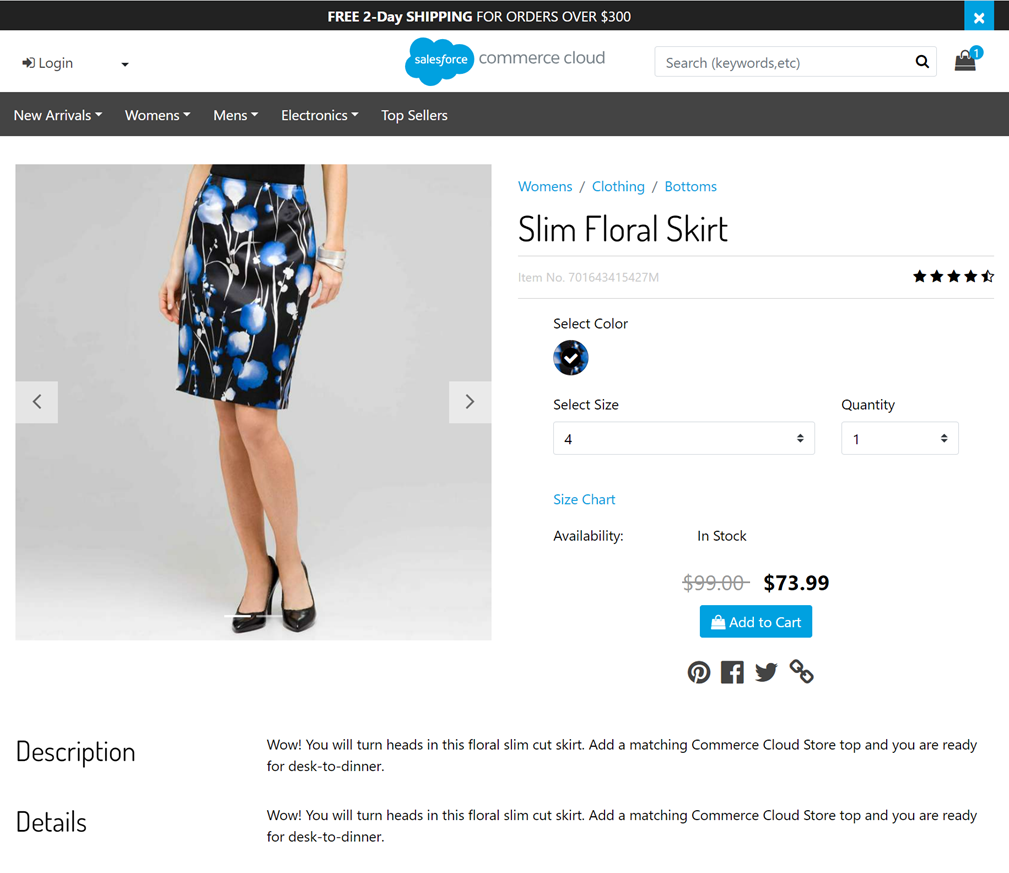Product Types in the Salesforce Commerce Cloud
Salesforce B2C Commerce uses various types of products that support different storefront ordering requirements, such as size, color, and customization options. That enables users to show and sell products in different combinations.
Below is a list of B2C Commerce product types:
- Standard: A one-off product or service. Example
- Main or Master Product: All the variations of a product. Example
- Variation group: A group of products or services that share at least one attribute, such as color, and are assigned to a base product. Example
- Variation: A specific instance of a base product. Example
- Product Set: Multiple products or services that are displayed together and can be ordered together or separately. Example
- Product Bundle: Multiple products or services that can only be sold as a group. Example
- Product Option: An add-on item that comes with a product or service, (for example, upgrades) but can't be bought separately. The item will have a separate price and display name. Example
- In this article, we ll briefly show how all product types can be used and configured, and how they are displayed in a storefront. For more information about each type you can find it in this module.
Not all products can be orderable, so below is a table for a better overview:

Standard (simple) Product
To create a simple product:
- Go to Merchant Tools >Products and Catalogs> Products.
- Click New.

As you can see, ID and Catalog are mandatory, but you ll also need to set the product Online.
Now let s have a look at a product:
In Business Manager (BM):

In Storefront:

Product attributes could be extended, depending on the needs.
Product Price comes from the PriceBook:

Master Product or Variation Base Product
Master Product is a parent product for Variation Products. Let us have a look:

As you can see, the product type is Variation Base Product. A variation product is a single product with specific values for all the base product attributes:

In the storefront, a shopper filters the base product down to a variation by selecting specific values for each product variation attribute:

The Master Product itself is not orderable. You can add it to the basket (which usually does not happen), but you won t be able to create an Order with such products in the Basket.
To Order this shirt you ll need to select a Color and a Size. In this case, a Variant will be added to the Basket.
Variation Product
A variation product is a single product with specific values for all the base product attributes. In the storefront, a shopper filters the base product down to a variation by selecting specific values for each product variation attribute. For example, a dress shirt that is blue and size 16. A variation product is a real product that has attributes in addition to the variation attributes, such as SKU, name, description, images, and price.
A Variation Product is the actual product that goes in the Basket and is orderable.


Variation Group


Product Set
You can configure a group of products to appear on a storefront as a product set. The customer can purchase the entire set of products or one of its elements.

BM View:

Set configuration:

Below is how products will appear on the storefront:

PDP:

You can add each product separately:

or all together:

Product Bundle

BM configurations for the products

Product Option
Salesforce B2C Commerce product options enable you to sell configurable products that have optional accessories, upgrades, or extra services.
Options are always purchased with a product and can't be purchased separately. They have their own price and display name, but do not have their own thumbnail images. A customer can t search for them, but they are visible on the product detail page.
For example, warranty for a camera or TV or the length for necklace:

Product configurations:

Options:

Note that prices for the options are configurable here as well, but not in the Price Book. For different currencies there is a dropdown, next to the language selection.
How it'll look on the Storefront:



